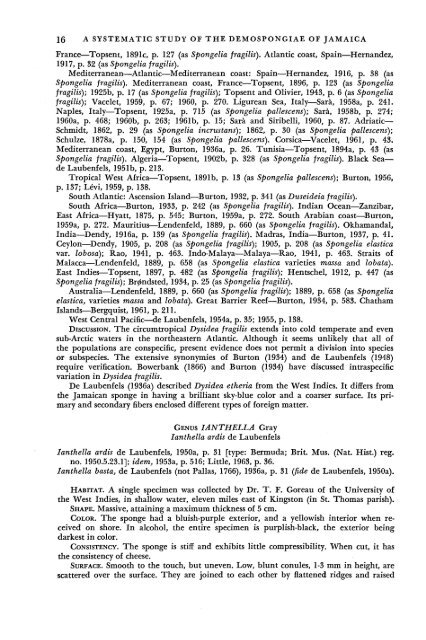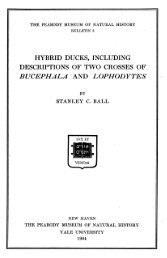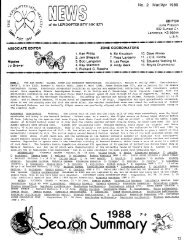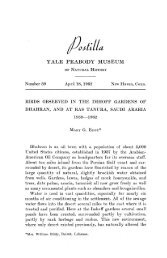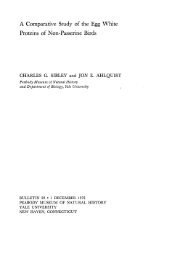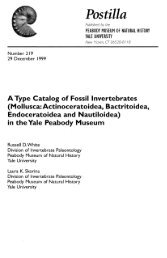Bulletin 20 - Peabody Museum of Natural History - Yale University
Bulletin 20 - Peabody Museum of Natural History - Yale University
Bulletin 20 - Peabody Museum of Natural History - Yale University
Create successful ePaper yourself
Turn your PDF publications into a flip-book with our unique Google optimized e-Paper software.
16 A SYSTEMATIC STUDY OF THE DEMOSPONGIAE OF JAMAICA<br />
France—Topsent, 1891c, p. 127 (as Spongelia fragilis). Atlantic coast, Spain—Hernandez,<br />
1917, p. 32 (as Spongelia fragilis).<br />
Mediterranean—Atlantic—Mediterranean coast: Spain—Hernandez, 1916, p. 38 (as<br />
Spongelia fragilis). Mediterranean coast, France—Topsent, 1896, p. 123 (as Spongelia<br />
fragilis); 1925b, p. 17 (as Spongelia fragilis); Topsent and Olivier, 1943, p. 6 (as Spongelia<br />
fragilis); Vacelet, 1959, p. 67; 1960, p. 270. Ligurean Sea, Italy—Sara, 1958a, p. 241.<br />
Naples, Italy—Topsent, 1925a, p. 715 (as Spongelia pallescens); Sara, 1958b, p. 274;<br />
1960a, p. 468; 1960b, p. 263; 1961b, p. 15; Sara and Siribelli, 1960, p. 87. Adriatic-<br />
Schmidt, 1862, p. 29 (as Spongelia incrustans); 1862, p. 30 (as Spongelia pallescens);<br />
Schulze, 1878a, p. 150, 154 (as Spongelia pallescens). Corsica—Vacelet, 1961, p. 43.<br />
Mediterranean coast, Egypt, Burton, 1936a, p. 26. Tunisia—Topsent, 1894a, p. 43 (as<br />
Spongelia fragilis). Algeria—Topsent, 1902b, p. 328 (as Spongelia fragilis). Black Sea—<br />
de Laubenfels, 1951b, p. 213.<br />
Tropical West Africa—Topsent, 1891b, p. 13 (as Spongelia pallescens); Burton, 1956,<br />
p. 137; Levi, 1959, p. 138.<br />
South Atlantic: Ascension Island—Burton, 1932, p. 341 (as Duseideia fragilis).<br />
South Africa—Burton, 1933, p. 242 (as Spongelia fragilis). Indian Ocean—Zanzibar,<br />
East Africa—Hyatt, 1875, p. 545; Burton, 1959a, p. 272. South Arabian coast—Burton,<br />
1959a, p. 272. Mauritius—Lendenfeld, 1889, p. 660 (as Spongelia fragilis). Okhamandal,<br />
India—Dendy, 1916a, p. 139 (as Spongelia fragilis). Madras, India—Burton, 1937, p. 41.<br />
Ceylon—Dendy, 1905, p. <strong>20</strong>8 (as Spongelia fragilis); 1905, p. <strong>20</strong>8 (as Spongelia elastica<br />
var. lobosa); Rao, 1941, p. 463. Indo-Malaya—Malaya—Rao, 1941, p. 463. Straits <strong>of</strong><br />
Malacca—Lendenfeld, 1889, p. 658 (as Spongelia elastica varieties massa and lobata).<br />
East Indies—Topsent, 1897, p. 482 (as Spongelia fragilis); Hentschel, 1912, p. 447 (as<br />
Spongelia fragilis); Br0ndsted, 1934, p. 25 (as Spongelia fragilis).<br />
Australia—Lendenfeld, 1889, p. 660 (as Spongelia fragilis); 1889, p. 658 (as Spongelia<br />
elastica, varieties massa and lobata). Great Barrier Reef—Burton, 1934, p. 583. Chatham<br />
Islands—Bergquist, 1961, p. 211.<br />
West Central Pacific—de Laubenfels, 1954a, p. 35; 1955, p. 138.<br />
DISCUSSION. The circumtropical Dysidea fragilis extends into cold temperate and even<br />
sub-Arctic waters in the northeastern Atlantic. Although it seems unlikely that all <strong>of</strong><br />
the populations are conspecific, present evidence does not permit a division into species<br />
or subspecies. The extensive synonymies <strong>of</strong> Burton (1934) and de Laubenfels (1948)<br />
require verification. Bowerbank (1866) and Burton (1934) have discussed intraspecific<br />
variation in Dysidea fragilis.<br />
De Laubenfels (1936a) described Dysidea etheria from the West Indies. It differs from<br />
the Jamaican sponge in having a brilliant sky-blue color and a coarser surface. Its primary<br />
and secondary fibers enclosed different types <strong>of</strong> foreign matter.<br />
GENUS IANTHELLA Gray<br />
Ianthella ardis de Laubenfels<br />
lanthella ardis de Laubenfels, 1950a, p. 31 [type: Bermuda; Brit. Mus. (Nat. Hist.) reg.<br />
no. 1950.5.23.1]; idem, 1953a, p. 516; Little, 1963, p. 36.<br />
lanthella basta, de Laubenfels (not Pallas, 1766), 1936a, p. 31 (fide de Laubenfels, 1950a).<br />
HABITAT. A single specimen was collected by Dr. T. F. Goreau <strong>of</strong> the <strong>University</strong> <strong>of</strong><br />
the West Indies, in shallow water, eleven miles east <strong>of</strong> Kingston (in St. Thomas parish).<br />
SHAPE. Massive, attaining a maximum thickness <strong>of</strong> 5 cm.<br />
COLOR. The sponge had a bluish-purple exterior, and a yellowish interior when received<br />
on shore. In alcohol, the entire specimen is purplish-black, the exterior being<br />
darkest in color.<br />
CONSISTENCY. The sponge is stiff and exhibits little compressibility. When cut, it has<br />
the consistency <strong>of</strong> cheese.<br />
SURFACE. Smooth to the touch, but uneven. Low, blunt conules, 1-3 mm in height, are<br />
scattered over the surface. They are joined to each other by flattened ridges and raised


